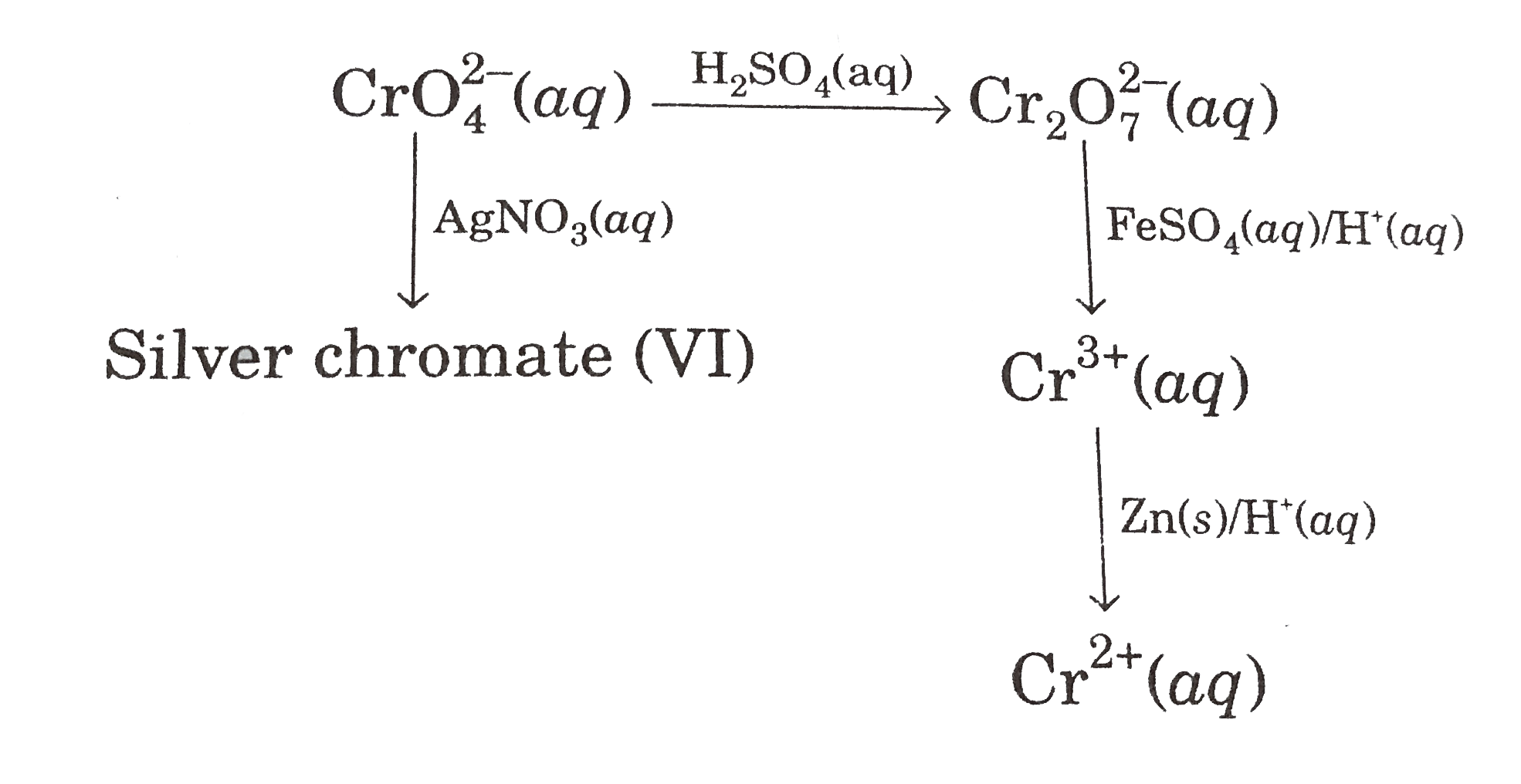Complete Solutions to Part -IV of chapter EQUIVALENT CONCEPT & TITRATIONS of Class 12 book with complete answers and questions
| Class 12 | CHEMISTRY |
| Chapter | EQUIVALENT CONCEPT & TITRATIONS |
| RESONANCE NEW | Part -IV |
| Number Of Questions | 22 |
| Academic Year | 2023-24 |
Volume `V_(1)mL` of 0.1 M `K_(2)Cr_(2)O_(7)` is needed for complete oxidation of 0.678g `N_(2)H_(4)` in acidic medium. The volume of 0.3M `KMnO_(4)` needed for same oxidation in acidic medium will be :
02:20View Solution`Hg_(5)(IO_(6))_(2)` oxidizes KI to `I_(2)` in acid medium and the other product containing iodine is `K_(2)HgI_(4)` . If the `I_(2)` liberated in the number of moles of `Hg_(5)(IO_(6))_(2)` that have reacted is :
03:26View Solution10 mL of 1 NHCl is mixed with 20 mL of 1`MH_(2)SO_(4)` and 30 mL of 1M NaOH. The resultant solution has:
03:03View Solution`20ml ofH_(2)O_(2)` after acidification with dilute `H_2SO_(4)`required 30mlof `(N)/(12)KMnO_4` for complete oxidation. The approximate strength of `H_(2)O_(2)` solution (ing/L)is : [Molar mass of `H_2O_2=34`]
02:34View Solution`x` gram of pure `As_(2)S_(3)` is completely oxididsed to respective highest oxidation states by 50 ml of 0.1 M hot acidified `KMnO_(4)`, then mass of `As_(2)S_(3)` taken is :
04:49View SolutionDuring the titration of a mixture of `Na_(2)CO_(3)` and `NaHCO_(3)` against HCl :
03:39View SolutionIn the reaction `CrO_(5) + H_(2)SO_(4)rarr Cr_(2)(sO_(4))_(3)+H_(2)O+O_(2)`, one mole of `CrO_(5)` will liberate how many molesof `O_(2)` :
02:27View SolutionConsider the redox reaction
`2S_(2)O_(3)^(2-)+I_(2)rarrS_(4)O_(6)^(2-)+2I^(ө)`01:33View SolutionWhich of the following relations is/are correct for solutions ?
04:04View SolutionWhich of the following statements is/are correct :
05:31View Solution`H_(2)C_(2)O_(4)` and `NaHC_(2)O_(4)` behave as acids as well as reducing agents. Which are the correct statements?
02:34View SolutionConsider the reactions shown below :

Which of the follwoing statements is false?04:21View SolutionA 3 mole mixture of `FeSO_(4)` and `Fe_(2)(SO_(4))_(3)` required 100 mL of 2M `KMnO_(4)` solution in acidic medium. Find the mole of `FeSO_(4)` in the mixture.
03:56View SolutionA 7.1 g sample of bleaching powder suspended in `H_(2)O` was treated with enough acetic acid and KI solution. Iodine thus liberated required 80 mL of 0.2 N hypo solution for titration. Calcutale the % of available chlorine :
03:43View SolutionIf the number of N-atoms in 1 molecule of Hyponitrous acid is x and the basicity of Boric acid is y, fing the sum (x+y).
02:51View SolutionFind the valency factor (n) for `NH_(2)OH` in given reaction :
`Fe^(3+)+NH_(2)OHrarrFe^(2+)+N_(2)O+H^(+)+H_(2)O`02:32View SolutionA solution of `Na_(2)S_(2)O_(3)` is standardised iodometrically against 3.34 g of pure `KBrO_(3)` (converted to `Br^(-)`), requiring 40 mL `Na_(2)S_(2)O_(3)` solution. What is the molarity of `Na_(2)S_(2)O_(3)` solution ? (Molar mass of `KBrO_(3)=167 g "mol"^(-1)`)
View Solution2 moles of a mixture of `O_(2)` and `O_(3)` is reacted with excess of acidified solution of KI. The iodine liberated require 1L of 2M hypo solution for complete reaction. The weight % of `O_(3)` in the initial sample is x. Find `(x)/(10)`
05:34View SolutionThe overall equation for the reaction between sodium carbonate solution and dilute hydrochloric acid is
`Na_(2)CO_(3)(aq.)+2HCl(aq.)rarrNaCl(aq)+CO_(2)(g)H_(2)O(l)`
If you had the two solutions of the same concentration, you would have to use double volume of HCl to reach the equivalence point.
Indicators change their colours at the end point of the reaction and hence we are able to know the end points (equivalence points of reactions).
How many ml of 1N HCl are required for X milimoles of `Na_(2)CO_(3)` with methyl orange indicatorView SolutionThe overall equation for the reaction between sodium carbonate solution and dilute hydrochloric acid is
`Na_(2)CO_(3)(aq.)+2HCl(aq.)rarrNaCl(aq)+CO_(2)(g)H_(2)O(l)`
If you had the two solutions of the same concentration, you would have to use double volume of HCl to reach the equivalence point.
Indicators change their colours at the end point of the reaction and hence we are able to know the end points (equivalence points of reactions).
How many ml of 1N HCl are required for X milimoles of NaOH + Y milimoles of `Na_(2)CO_(3)+Z` milimoles of `NaHCO_(3)`with methyl orange indicatorView SolutionThe overall equation for the reaction between sodium carbonate solution and dilute hydrochloric acid is
`Na_(2)CO_(3)(aq.)+2HCl(aq.)rarrNaCl(aq)+CO_(2)(g)H_(2)O(l)`
If you had the two solutions of the same concentration, you would have to use double volume of HCl to reach the equivalence point.
Indicators change their colours at the end point of the reaction and hence we are able to know the end points (equivalence points of reactions).
25 ml of `Na_(2)CO_(3)` solution requires 100 ml of 0.1 M HCl to reach end point with phenolphthalein indicator. Molarity of `HCO_(3^(-))` ions in the resulting solution isView Solution View Solution
View Solution
Part -IV questions and complete solutions for chapter EQUIVALENT CONCEPT & TITRATIONS of PHYSICAL, INORGANIC, AND ORGANIC CHEMISTRY of Class 12
All Exercises from RESONANCE NEW Class 12 CHEMISTRY EQUIVALENT CONCEPT & TITRATIONS
- APSP (Part-I)
- APSP (Part-II)
- APSP (Part-III)
- Exercise -1 (Part-II)
- Exercise -1 (Part-I )
- Exercise -1 (Part-III)
- Exercise -2 (Part-I)
- Exercise -2 (Part-II)
- Exercise -2 (Part-III)
- Exercise -2 (Part-IV)
- Exercise -3 (JEE(MAIN) Online problems)
- Exercise -3 (Part-I)
- Exercise -3 (Part-II)
- Miscellaneous solved problems
- Part -IV
- Solved Examples
